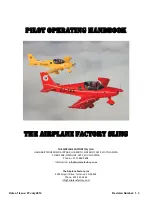
CESSNA AIRCRAFT COMPANY
FOR TRAINING USE ONLY
MODEL 152
4-14
TAKEOFF
POWER CHECK
It is important to check full-throttle engine operation early in the takeoff run. Any sign of rough engine
operation or sluggish engine acceleration is good cause for discontinuing the takeoff. If this occurs, you
are justified in making a thorough full-throttle static run-up before another takeoff is attempted. The
engine should run smoothly and turn approximately 2280 to 2380 RPM with carburetor heat off and
mixture leaned to maximum RPM.
Full throttle run-ups over loose gravel are especially harmful to propeller tips. When takeoffs must be
made over a gravel surface, it is very important that the throttle be advanced slowly. This allows the
airplane to start rolling before high RPM is developed, and the gravel will be blown back of the propeller
rather than pulled into it. When unavoidable small dents appear in the propeller blades, they should be
immediately corrected as described in Section 8 under Propeller Care.
Prior to takeoff from fields above 3000 feet elevation, the mixture should be leaned to give maximum
RPM in a full-throttle, static run-up.
After full throttle is applied, adjust the throttle friction lock clockwise to prevent the throttle from
creeping back from a maximum power position. Similar friction lock adjustment should be made as
required in other flight conditions to maintain a fixed throttle setting.
WING FLAP SETTING
Normal takeoffs are accomplished with wing flaps 0° - 10°. Using 10° wing flaps reduces the total
distance over an obstacle by approximately 10%. Flap deflections greater than 10° are not approved for
takeoff. If 10° wing flaps are used for takeoff, they should be left down until all obstacles are cleared
and a safe flap retraction speed of 60 KIAS is reached.
On a short field, 10° wing flaps and an obstacle clearance speed of 54 KIAS should be used. This speed
provides the best overall climb speed to clear obstacles when taking into account turbulence often
found near ground level.
Soft or rough field takeoffs are performed with 10° wing flaps by lifting the airplane off the ground as
soon as practical in a slightly tail-low attitude. If no obstacles are ahead, the airplane should be leveled
off immediately to accelerate to a higher climb speed.
Takeoffs into strong crosswinds normally are performed with the minimum flap setting necessary for the
field length, to minimize the drift angle immediately after takeoff. The airplane is accelerated to a speed
slightly higher than normal, then pulled off abruptly to prevent possible settling back to the runway
while drifting. When clear of the ground, make a coordinated turn into the wind to correct for drift.
Содержание 152 1978
Страница 2: ...CESSNA AIRCRAFT COMPANY FOR TRAINING USE ONLY MODEL 152 PAGE INTENTIONALLY BLANK ...
Страница 6: ...CESSNA AIRCRAFT COMPANY FOR TRAINING USE ONLY MODEL 152 1 2 PAGE INTENTIONALLY BLANK ...
Страница 7: ...CESSNA AIRCRAFT COMPANY FOR TRAINING USE ONLY MODEL 152 1 3 THREE VIEWS Figure 1 1 Three View ...
Страница 8: ...CESSNA AIRCRAFT COMPANY FOR TRAINING USE ONLY MODEL 152 1 4 PAGE INTENTIONALLY BLANK ...
Страница 16: ...CESSNA AIRCRAFT COMPANY FOR TRAINING USE ONLY MODEL 152 2 2 PAGE INTENTIONALLY BLANK ...
Страница 24: ...CESSNA AIRCRAFT COMPANY FOR TRAINING USE ONLY MODEL 152 2 10 PAGE INTENTIONALLY BLANK ...
Страница 48: ...CESSNA AIRCRAFT COMPANY FOR TRAINING USE ONLY MODEL 152 4 10 PAGE INTENTIONALLY BLANK ...
Страница 78: ...CESSNA AIRCRAFT COMPANY FOR TRAINING USE ONLY MODEL 152 6 2 PAGE INTENTIONALLY BLANK ...
Страница 80: ...CESSNA AIRCRAFT COMPANY FOR TRAINING USE ONLY MODEL 152 6 4 Figure 6 1 Sample Airplane Weighing ...
Страница 81: ...CESSNA AIRCRAFT COMPANY FOR TRAINING USE ONLY MODEL 152 6 5 Figure 6 2 Sample Weight and Balance Record ...
Страница 84: ...CESSNA AIRCRAFT COMPANY FOR TRAINING USE ONLY MODEL 152 6 8 Figure 6 5 Internal Cabin Dimensions ...
Страница 85: ...CESSNA AIRCRAFT COMPANY FOR TRAINING USE ONLY MODEL 152 6 9 Figure 6 6 Sample Loading Problem ...
Страница 86: ...CESSNA AIRCRAFT COMPANY FOR TRAINING USE ONLY MODEL 152 6 10 Figure 6 7 Loading Graph ...
Страница 87: ...CESSNA AIRCRAFT COMPANY FOR TRAINING USE ONLY MODEL 152 6 11 Figure 6 8 Center of Gravity Moment Envelope ...
Страница 88: ...CESSNA AIRCRAFT COMPANY FOR TRAINING USE ONLY MODEL 152 6 12 Figure 6 9 Center of Gravity Limits ...
Страница 100: ...CESSNA AIRCRAFT COMPANY FOR TRAINING USE ONLY MODEL 152 7 4 Figure 7 1 Flight Control and Trim Systems Sheet 1 of 2 ...
Страница 101: ...CESSNA AIRCRAFT COMPANY FOR TRAINING USE ONLY MODEL 152 7 5 Figure 7 1 Flight Control and Trim Systems Sheet 2 of 2 ...
Страница 102: ...CESSNA AIRCRAFT COMPANY FOR TRAINING USE ONLY MODEL 152 7 6 Figure 7 2 Instrument Panel Sheet 1 of 2 ...
Страница 108: ...CESSNA AIRCRAFT COMPANY FOR TRAINING USE ONLY MODEL 152 7 12 Figure 7 4 Seat Belts and Shoulder Harnesses ...
Страница 128: ...CESSNA AIRCRAFT COMPANY FOR TRAINING USE ONLY MODEL 152 8 2 PROPELLER CARE 13 ENGINE CARE 13 INTERIOR CARE 14 ...
Страница 144: ...CESSNA AIRCRAFT COMPANY FOR TRAINING USE ONLY MODEL 152 9 4 PAGE INTENTIONALLY BLANK ...
Страница 146: ...CESSNA AIRCRAFT COMPANY FOR TRAINING USE ONLY MODEL 152 9 6 PAGE INTENTIONALLY BLANK ...
Страница 150: ...CESSNA AIRCRAFT COMPANY FOR TRAINING USE ONLY MODEL 152 9 10 PAGE INTENTIONALLY BLANK ...
Страница 154: ...CESSNA AIRCRAFT COMPANY FOR TRAINING USE ONLY MODEL 152 9 14 PAGE INTENTIONALLY BLANK ...
Страница 164: ...CESSNA AIRCRAFT COMPANY FOR TRAINING USE ONLY MODEL 152 9 24 PAGE INTENTIONALLY BLANK ...
Страница 188: ...CESSNA AIRCRAFT COMPANY FOR TRAINING USE ONLY MODEL 152 9 48 PAGE INTENTIONALLY BLANK ...
Страница 192: ...CESSNA AIRCRAFT COMPANY FOR TRAINING USE ONLY MODEL 152 9 52 PAGE INTENTIONALLY BLANK ...














































